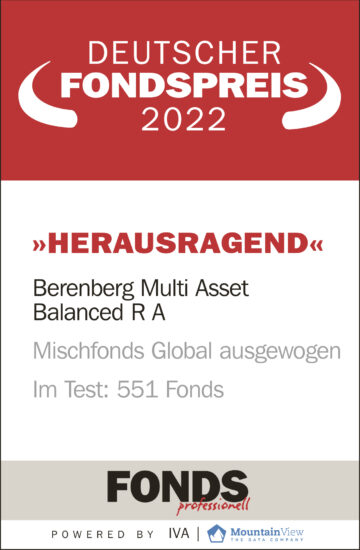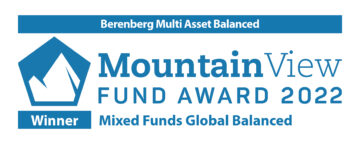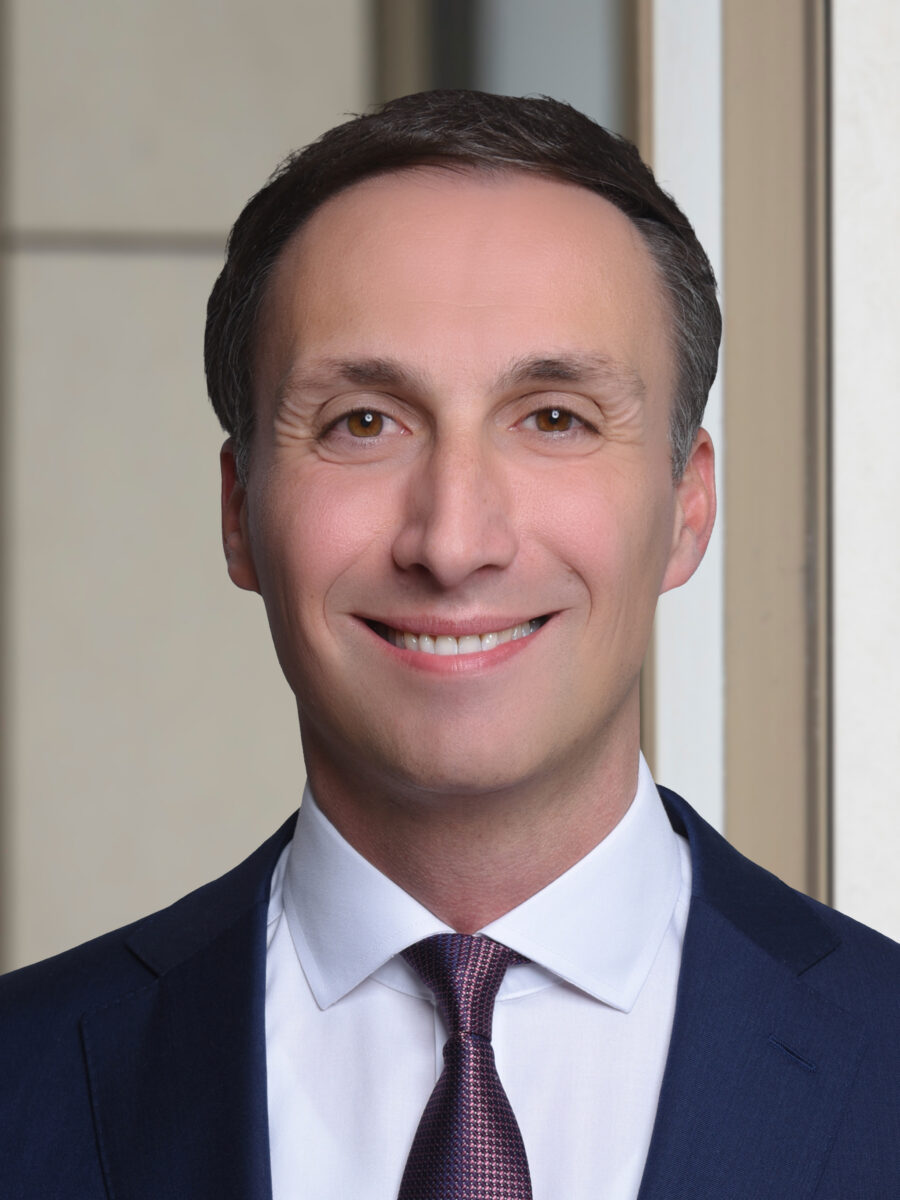Investment Strategy
The Berenberg Multi Asset Balanced fund pursues a balanced strategy comprising equities, bonds, alternative investments and cash. The strategy aims at a balanced participation in the capital market and a long-term focus on structural growth trends and quality companies. The respective investment ratios are actively and dynamically managed based on the relative attractiveness of the asset class. In the equity segment, the focus lies on high-quality growth companies. European issuers with good credit ratings dominate on the bond side. Promising niche segments are covered via active funds. Alternative investments provide uncorrelated returns that stabilize the portfolio.
- Our classic multi-asset strategy for balanced participation in the capital market
- Active positioning against a mixed market benchmark
- Maximum equity allocation of 65%
- The investment universe primarily comprises individual securities, but also funds and ETFs
Learn more about our Berenberg Multi Asset investment philosophy


Fund data
| ISIN | DE000A0MWKF5 |
|---|---|
| WKN | A0MWKF |
| Inception date | 31.10.2007 |
| Issue price (27.03.2025) | 72.96 EUR |
| Redemption price (27.03.2025) | 69.16 EUR |
| Fund volume | 325.06 Mio. EUR |
| Share class volume | 199.24 Mio. EUR |
| Currency Fund / Share Class | EUR / EUR |
| Minimum investment | - |
| Asset Manager | Joh. Berenberg, Gossler & Co. KG |
| Management company | Universal-Investment-Gesellschaft mbH |
| Custodian | BNP Paribas S.A. Niederlassung Deutschland |
| Use of income | Accumulating |
| End of financial year | 31.12. |
| Registration and Distribution | DE |
| SFDR Classification (Sustainable Finance Disclosure Regulation) | Article 8 |
Costs
| Issue surcharge | Up to 5.50% |
|---|---|
| Flat-rate fee p.a. | 1.56% |
| Total Expense Ratio (TER) p.a. | 1.59% |
| Performance fee | none |
Chances and risks
| Chances | Risks |
|---|---|
| Asset preservation, primarily achieved through interest income, dividends and price gains | Substantial fluctuations in value and significant price losses possible |
| Stabilization of assets in negative capital market phases through professional risk management and intelligent diversification | Currency losses due to exchange rate fluctuations |
| Improvement of the risk/return profile through active management across all bond segments | Limited participation in positive performance of individual bond segments due to broad diversification and negative selection effects in individual security and fund selection |
Further details on the opportunities and risks of this fund can be found in the sales prospectus.
Indexed performance
Performance in 12-month periods
Monthly performance
| Year | Jan | Feb | Mar | Apr | May | Jun | Jul | Aug | Sep | Oct | Nov | Dec | YTD |
|---|---|---|---|---|---|---|---|---|---|---|---|---|---|
| 2015 | 3.62 | 2.56 | 0.67 | -0.41 | 0.67 | -2.36 | 0.83 | -3.94 | -2.32 | 4.10 | 1.50 | -3.29 | 1.25 |
| 2016 | -3.96 | -0.45 | 0.39 | -0.12 | 1.66 | -0.78 | 1.74 | -0.02 | -0.22 | -1.16 | 0.18 | 2.34 | -0.55 |
| 2017 | -0.24 | 2.24 | 0.99 | 0.35 | 0.38 | -1.16 | -0.60 | -0.39 | 1.40 | 1.08 | -1.12 | 0.52 | 3.44 |
| 2018 | 0.81 | -2.04 | -1.90 | 1.92 | 1.90 | -1.14 | 1.31 | 0.55 | -0.53 | -4.49 | -0.32 | -4.58 | -8.44 |
| 2019 | 4.95 | 2.36 | 1.85 | 3.47 | -1.89 | 2.59 | 1.56 | 0.00 | 0.24 | 0.69 | 2.40 | 1.52 | 21.42 |
| 2020 | 0.45 | -3.47 | -8.76 | 6.71 | 3.29 | 1.96 | 1.48 | 2.77 | -0.48 | -1.84 | 4.94 | 3.26 | 9.77 |
| 2021 | 0.90 | 1.15 | 1.45 | 3.10 | 0.62 | 2.17 | 2.35 | 2.10 | -3.41 | 3.01 | -0.01 | 0.84 | 15.03 |
| 2022 | -6.94 | -2.35 | 1.91 | -2.82 | -2.54 | -4.46 | 5.64 | -3.46 | -5.20 | 1.06 | 3.96 | -3.08 | -17.50 |
| 2023 | 4.24 | -0.86 | 0.19 | -0.37 | 0.06 | -0.02 | 1.17 | -1.52 | -1.56 | -1.34 | 3.88 | 2.59 | 6.43 |
| 2024 | 0.75 | 1.27 | 1.92 | -1.26 | 1.32 | 1.36 | 0.55 | 0.66 | 0.29 | -1.16 | 2.74 | -1.43 | 7.13 |
| 2025 | 3.98 | -0.39 | - | - | - | - | - | - | - | - | - | - | 0.51 |
Source: Berenberg, Management company
The charts and tables regarding performance shown here are based on own calculations according to the method developed by the German Investment Funds Association (BVI). They illustrate past performance. Future performance can deviate both positively and negatively from these calculations. Gross performance (BVI method) takes into account all charges at fund level (e.g. management fee), net performance plus the issue surcharge. Additional charges can arise for individual investors (e.g. custody account fees, commissions and other fees). Model calculation (net): An investor wants to purchase fund units for EUR 1,000 EUR. Considering a max issue surcharge of 5.50% he has to payEUR 55.00 for the purchase. Also, fees may be charged for the administration of the safe custody account, which will lower the performance. Past performance is not a reliable indicator of future performance.
Performance after issue surcharge
| 1 year | 3.80% |
|---|---|
| 3 years | 2.46% |
| 5 years | 37.33% |
| since inception | 42.24% |
| Max. Drawdown 5 years | -21.09% |
Source: Berenberg, Management company | State: 27 Mar 2025
Risk figures
| Volatility - 1 year | 6.62% |
|---|---|
| Volatility - 3 years | 6.92% |
| Sharpe Ratio - 3 years | -0.24 |
| Maximum Drawdown - since inception | -25.55% |
Currencies
Asset classes
Top Holdings
Equities - Sectors
Equities - Countries
Bonds - Sectors
Bonds - Countries
Monthly market comment
Global equities ended February down 0.8%. The technology sector came under pressure on concerns about artificial intelligence, while European banks posted strong gains. Overall, European markets outperformed their US counterparts. Given the current slowdown in US growth, we increased our focus on large-cap companies and reduced our position in the US mid-cap segment. The emerging recovery in China led us to increase our equity exposure in emerging markets. Weaker US economic data, the temporary absence of an escalation in the trade conflict and a loss of momentum in US government bonds led to a decline in yields. Investment grade credit spreads widened slightly in both Europe and the US. The prospect of possible peace in Ukraine and the foreseeable increase in European defense spending supported the euro. Overall, 2025 is likely to be characterized by high volatility. While interest rate cuts and fiscal stimulus are supportive, the balance between growth, inflation and political risks remains crucial. Balanced market positioning therefore remains prudent.
Portfolio Management

Dejan Djukic
Dejan Djukic heads up portfolio management at Berenberg. He is responsible for the discretionary mandates and the asset management solutions with multi-asset focus. He is a member of the Asset Allocation Committee and portfolio manager of various multi-asset strategies. After completing his Master’s degree in finance, he began his career at Commerzbank AG. Djukic was there responsible for asset allocation for asset management and fund mandates. He was also a voting member of the global investment committee and managed the bank's largest mutual funds and individual mandates. He then took over responsibility for portfolio management at DZ Privatbank S.A.. The team was responsible for the bank's large and special mandates.

Christian Bettinger
Christian Bettinger has been with the company since June 2009 and heads the Portfolio Management Fixed Income department. As fund manager of the mutual funds Berenberg Euro Bonds and Berenberg Financial Bonds, he is responsible for the selection of corporate bonds. He trained as a banker and then studied business administration at the Catholic University of Eichstätt-Ingolstadt. In 2010, the business graduate was taken on early from the Berenberg trainee program as a fund manager with a focus on derivatives and bonds. Bettinger is a CFA Charterholder, Certified Financial Engineer (CFE) and authorized Eurex trader.


